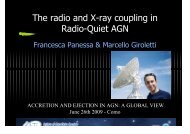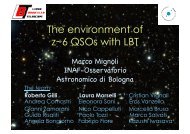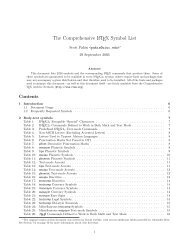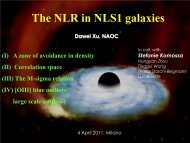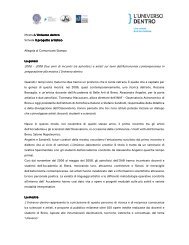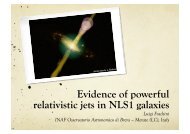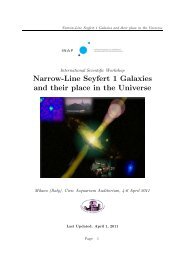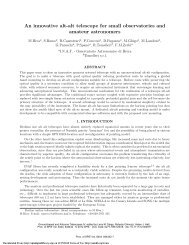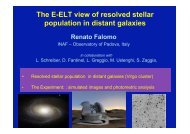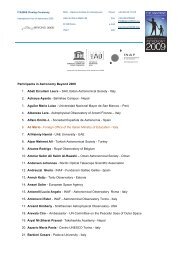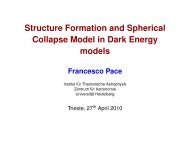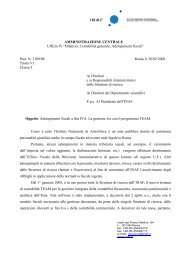IASFRome_StatusReport - INAF-IASF-Roma
IASFRome_StatusReport - INAF-IASF-Roma
IASFRome_StatusReport - INAF-IASF-Roma
Create successful ePaper yourself
Turn your PDF publications into a flip-book with our unique Google optimized e-Paper software.
<strong>IASF</strong> <strong>Roma</strong> - STATUS REPORTfor the Visiting CommitteeRef: <strong>IASF</strong>-RM-VC-001/07DATA: 19 November 2007Page: 18/134opto-mechanical tools and platform, high resolution FTIR for extended range from visible andmedium infrared, make possible to fulfill all of the required measurements supporting thecalibration, the interpretation of data acquired in flight and in support to mathematical modeling.As an example, the most recent setup under construction will be able in a short time to performdedicated measurements of the optical properties of gases in extreme conditions of highpressure and temperature and also for very elongated optical paths by using the cavity ringdown technique.2.1.1 Staff MembersDirigente di Ricerca: G.B. ValsecchiI° Researcher: F. Capaccioni, A. Carusi, P. Cerroni, G. Magni,Researchers:, M.T. Capria, M.C. De Sanctis, G. Filacchione, R. Orosei, G. PiccioniEngineers: M. ZambelliTechnicians: A. Boccaccini, A.M. SambucoCollaborators: A. Boattini, A. Cardesin, V. Cottini, G. D'Abramo, O. Lanciano, A. Migliorini,R. Politi2.2 Stars, Stellar Population and Interstellar MediumA proper understanding of our Universe requires the knowledge of the evolutionary properties ofthe stars. They are responsible, e.g., of the re-ionization at Z=5-6, of its chemical evolution,they can inhibit and/or trigger new star formation, they contribute to the dynamical evolution ofgalaxies and are a continuous source of neutrinos. Their dynamics reflects the average one oftheir host galaxy. The determination of their age, chemical composition, surface luminosity andradius provide precious information concerning the age of the Universe, the Big Bangnucleosynthesis, the first phases of chemical enrichment of the primordial gas, the distancescale, and hints about the formation and evolution of galaxies.With the directorship of Livio Gratton first and Vittorio Castellani later, the “Laboratorio diAstrofisica Spaziale in Frascati” became rapidly synonymous of “stellar evolution” and still themajority of italian theoreticians working in stellar modeling has scientifically grown in “Frascati”.Though in this last decade a number of people working in this field evaporated either becausethey won leading positions in other Institutions or because they retired, work on “stars” is stillvery active at <strong>IASF</strong>, both from the theoretical and observational sides. Very schematically themain activities may be sketched as follows:1) stellar modeling Massive Stars: hydrostatic evolution, explosion andnucleosynthesis(database of yields, extremely metal poor stars, radioactive nuclei)Intermediate Mass Stars: evolution and nucleosynthesis(S-process and light elements nucleosynthesis)Low Mass Stars: H and He burnings(GC: distance scale, formation; chemical composition; Sun andstars: equation of state,rotation)2) observations Infrared: Star formation(IMF in nearby dark clouds. Young stellar objects in giantmolecular clouds)Observation of very massive stars(early evolutionary phases of very massive stars)18



